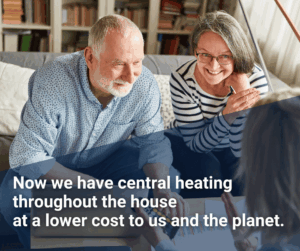Alan’s story
 Alan’s journey to a warmer, greener home
Alan’s journey to a warmer, greener home
“Now we have central heating throughout the house at lower cost to us and the planet.”
For Alan and his partner, retirement brought time to reflect, not just on the years behind them, but on the home they hoped to enjoy for many more to come. Sharing their 200-year-old stone cottage near St Cleer, Cornwall, with their adult grandchild, they found themselves living in a house full of character, but also full of challenges.
The four-bedroom detached cottage with its thick granite walls, had an ageing oil-fired boiler and wood burner which were expensive to run and increasingly unfit for their needs. They also wanted to extend their heating to cover all the bedrooms instead of just one.
They weren’t just looking for a warmer home. They were looking for peace of mind, lower bills, and a way to reduce their carbon footprint in their home, while making sure their home would support them as they grew older.
A house with history, and a need for change
Alan’s home had long relied on an oil-fired central heating system that was both inefficient and incomplete. The boiler only served part of the house, and the thick stone walls made it difficult to retain heat. As energy prices rose and the climate crisis became more urgent, Alan and his family decided it was time to act.
They wanted to:
- Eliminate their reliance on oil
- Reduce their carbon footprint
- Make every room in the house warm and usable
- Lower their energy bills and protect their retirement income
- Create a home that would be comfortable and manageable for years to come
A whole-house approach to comfort and peace of mind
Alan knew that to make a real difference, he needed to look at the house as a whole – not just replace the old oil boiler, but to rethink how the home could work better for the whole family. With support from the government’s Boiler Upgrade Scheme, he was able to access a £5,000 grant (now £7,500), which helped cover the cost of installing a modern air-to-water heat pump.
This new system replaced the oil-fired boiler entirely and now provides clean, consistent heating throughout the home. To make the most of the upgrade, Alan also upgraded the radiators and added underfloor heating in the kitchen.
They didn’t stop there. To help keep more heat contained in their home, they added to their existing loft insulation and insulated the inside of the gable end walls of the house with sustainable materials recommended by their supplier (30mm thick wood fibre board, bonded to the wall and finished with lime plaster). Their supplier calculated this would reduce heat loss through the insulated walls to about a third of its previous level. And to reduce their electricity bills, they installed 14 solar panels on the roof, enough to generate a good portion of the energy they now use.
Living the difference every day
Alan and his family have felt the changes in every corner of the house. The whole house can be kept warm throughout the winter.
Alan and his partner have also noticed a real difference in their energy bills. By using a smart electricity tariff, they heat the home during off-peak hours and make the most of the solar panels during the day. The result? A noticeable drop in their monthly costs.
They estimate they’re now saving around £860 a year on heating and £800 a year on electricity, a total of £1,660 in annual savings*. That’s money that now goes further in retirement, and it’s helped them feel more in control of their household expenses.
“We’ve saved hundreds of pounds a year, but more than that, we’ve gained peace of mind. We’re not worrying about oil deliveries or price spikes anymore.”
Alan has also been pleased with how the new systems perform day to day. The heat pump runs quietly and efficiently, and the solar panels generate a good amount of electricity. They’ve also made the most of their smart tariff.
“We use the Octopus Cosy tariff and set the thermostat to 20°C during cheaper hours, dropping to 18°C during peak times. That alone saves us around 25% on standard electricity costs.”
The combination of insulation, low-carbon heating, and solar energy has made the home not only more comfortable, but also more affordable to run.
*As of 2024
Not without its challenges
Like many big changes, the journey wasn’t without its problems. Alan chose the cheapest of three quotes for the heat pump installation, but the company went out of business shortly after the work was completed. He had to pay for some remedial work himself.
“It was frustrating, but we learnt a lot. Next time, we’d prioritise reliability over price.”
There was also some disruption during the installation, particularly when the underfloor heating and internal insulation were being fitted – the family chose to go on holiday during this work.
Alan felt it important to keep their wood burning stoves as a backup, but only needed to use them twice in two years – once during a power cut, and once when the heat pump needed a quick repair under warranty.
A warmer, more sustainable home for the future
Alan’s retrofit shows what’s possible, even in a 200-year-old stone cottage. By combining low carbon heating, insulation, and solar energy, they’ve created a home that’s warmer, more comfortable, and significantly cheaper to run.
The journey wasn’t without its challenges, but the results speak for themselves: lower bills, reduced emissions, and a home that’s ready for the future.
Big changes, brighter future
Alan’s experience is a great example of how older homes can be transformed with the right approach. And if you’re not sure where to start, support is available to help you take the first step.
“Don’t be put off by the scale of the work. It’s a big change, but it’s worth it. The house is warmer, our bills are lower, and we’ve done something good for the planet.”
At a Glance: Alan’s Journey
Before:
- Oil-fired heating only served part of the house
- Cold bedrooms and high heating bills
- No insulation or renewable energy
After:
- Whole-home warmth with air source heat pump
- Installation of 12 new radiators and underfloor heating in kitchen
- Solar PV to offset electricity use
- Loft and internal wall insulation for better heat retention
- Lower energy bills and reduced carbon footprint


Thinking of making a change?
If you’re inspired by Alan’s story but unsure where to begin, you’re not alone. Whether you’re looking for advice on grants, choosing the right installer, or understanding how to make your home more energy efficient, we’re here to help. Sometimes, the first step is simply having a conversation.
We’re offering free home visits where we can come and have a chat about the retrofit solutions you can consider for you and your home, plus ways of funding your project. We can even point you in the right direction of reputable, accredited contractors, so you know the improvements you make are in good hands.
We also have a range of energy advice guides which you can view or download.
To book a free home visit, please contact our Cornwall Low Carbon Energy Advice Network team
Please review our disclaimer information to understand the terms and conditions associated with using this service.

